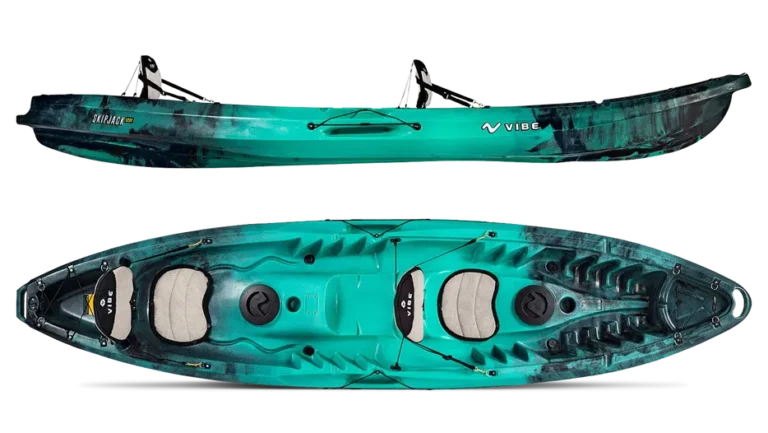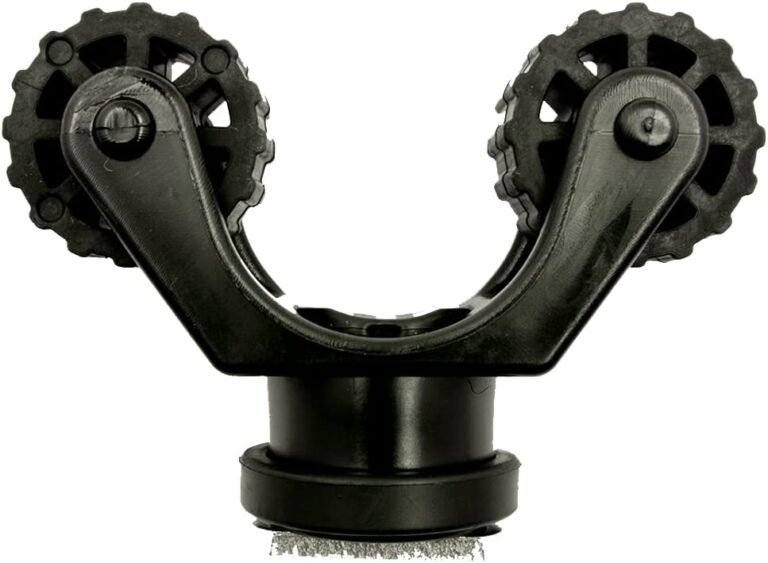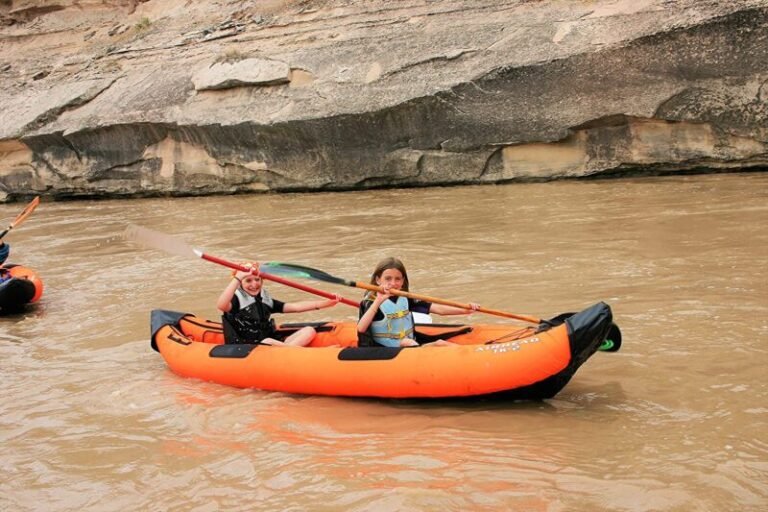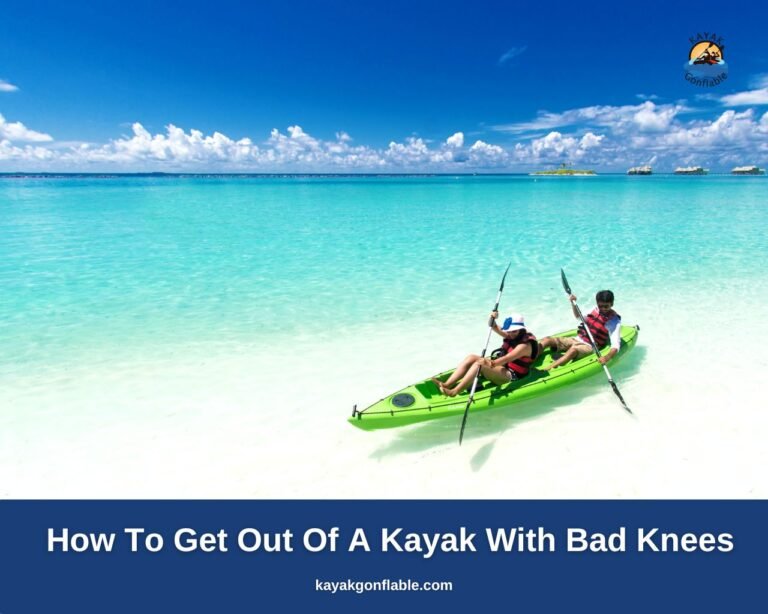10 Best Lightweight Kayaks To Buy In 2025
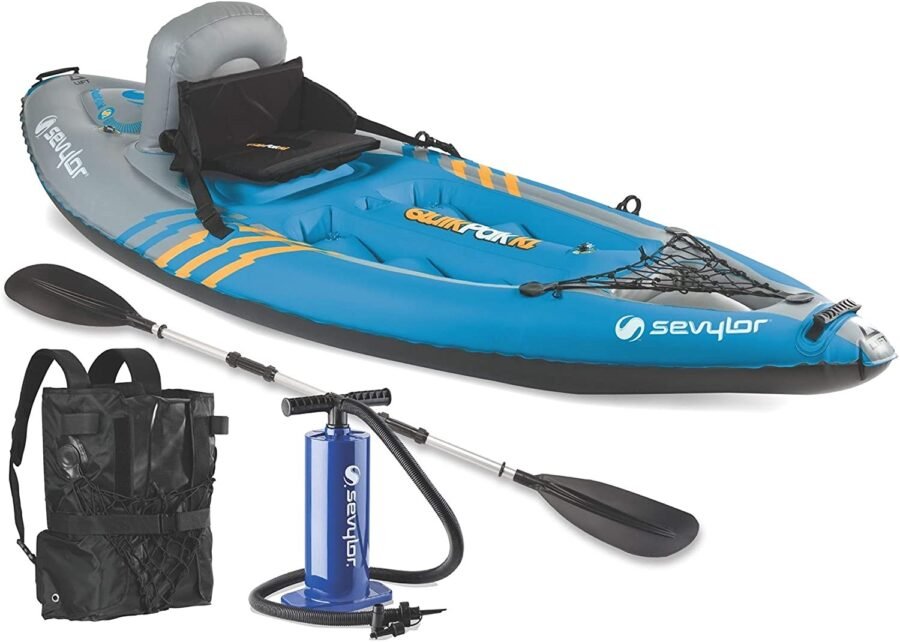
Which Portable Kayak Should I Get?
Kayaks are big, heavy, and clunky pieces of equipment, and hauling around a heavy boat can make you feel like you just spent a few hours pumping iron at the gym.
Most of the time, some of the best sweeping vistas and tranquil waters are far away from the nearest parking lot, and to get further out there you need a lightweight kayak in your arsenal that you can quickly and easily transport without the hassle that heavier kayaks bring.
A quality lightweight kayak can be carried long distances to access more remote bodies of water. They’re more efficient, highly responsive to paddle strokes and glide farther in the water than a comparable heavy kayak.
They’re foldable, fit inside a storage bag, and are always a few feet away from a good time. The best lightweight kayaks differ for everyone and depend solely on your needs and preferences.
If you’ve narrowed in on wanting a lightweight design, finding the perfect light and nimble kayak for your needs can be a challenge because there are dozens of options to choose from.
So here is the review of the 10 best lightweight kayaks on the market, along with other factors that you may want to consider before your purchase.
1. Intex Challenger K1 Kayak
Intex Challenger is probably the most popular entry-level inflatable kayak and a viable option for occasional recreational paddlers looking to save space and money.
Simple, portable, and easy to inflate/deflate, this inflatable kayak is expertly designed to provide you with the best overall paddling experience possible.
Made from an extremely puncture-resistant vinyl material, this cockpit is light and compact but compared with the higher-level inflatable kayaks made from reinforced PVC, it is not durable enough.
Included in this boat are 2 separate inflatable chambers, a large cargo net on the bow for your minimal gear, a plastic skeg on the bottom that helps it track better, a hand pump, a 3-piece paddle, and a repair patch.
The Boston valves make for quick inflation and deflation and the inflatable seat and backrest are designed for maximum comfort and space. The I-beam flooring ensures maximum stability while the ergonomic frame allows you to cut through lakes and rivers with ease.
It packs away nicely in the included carry bag and the bright and sporty-looking graphics lend it a bolder look and improve its visibility.
The 9-foot sit-on-top kayak is compact and weighs a comfortable 27.2 pounds, but its weight capacity is limited to 220 pounds.
Pros
- Excellent for beginners as it is cheap and stable
- Puncture-resistant, two-chamber vinyl hull
- A front cargo net
- Sporty graphics for improved visibility
- A carrying bag is included for hassle-free transport
- Paddle, repair patch, and paddle included
Cons
- Limited capacity especially for larger
- The cockpit tends to warm up
- The included paddle and carrying bag feel rather flimsy
2. Intex Explorer K2 Kayak
Coming in at just 30 pounds, Intex Explorer K2 Kayak is one of the lightest two-person options available in the market. Its lightweight construction, compact size, and low price make it an easy first step into kayaking.
This watercraft is made from vinyl which boasts puncture-proof resilience and includes three main inflatable chambers (two sides and the I-beam floor).
Created with comfort in mind, this boat comes with two inflatable seats that are attached with velcro strips on the bottom and side straps that provide back support, removable skegs for easy tracking, and two aluminum oars as well as grab lines.
This short kayak also features an open canoe-like design with small decks on the bow and stern, a carry bag, a repair kit, a hand pump, and carrying handles on the bow and the stern.
Rated for up to 400 lbs, it is best used for short recreational paddles on small, calm bodies of water and the bright yellow color will make you extra visible to others out on the water.
Pros
- Carry handles included
- Made from durable material
- Adjustable inflatable seat
- Compact size and lightweight construction
- Affordable
- 3 Separate air chambers
Cons
- Best suited for smaller paddlers
- Pretty short for a tandem
- Limited legroom, storage space, and capacity
3. Intex Excursion Pro
Intex Excursion Pro is a well-equipped and durable kayak that is suitable for longer fishing trips or even overnight camping trips.
It is made from a 3-ply PVC laminate with a polyester core, for high strength and durability, ensuring high impact and abrasion resistance, while retaining light weight and portability.
High-pressure inflation provides extra rigidity and stability, and the high-pressure spring-loaded valves make for easy inflation and fast deflation.
Included in this kayak are 2 removable inflatable seats that slide fore and aft on velcro strips, 2 collapsible paddles (you may need to replace them soon), a pressure gauge, adjustable footrests, two skews for optimal maneuverability through deep and shallow waters, a hand pump, a removable seat booster that lets you sit higher and a mounting bracket for your fishing accessories.
It also features two hard-to-use flush-mount rod holders, repair kits, and 86-inch Aluminum Oars. After use, this kayak is conveniently packed away with the carry bag.
At 39 lbs. (17.7 kg), Intex Excursion Pro is the heaviest kayak in Intex’s line but is still very lightweight. With a total weight capacity of 400 pounds (180 kg), this kayak can accommodate one average-sized adult with enough fishing or camping gear or two smaller persons with limited gear.
Pros
- Made from durable material
- Fast and stable in the water
- Portable and compact
- Easy to inflate and deflate as well as lightweight
- Adjustable inflatable seat
- Skews for optimal maneuverability
- flush-mounted footrests, integrated recessed fishing rod holders, and repair kits included
- High impact and abrasion resistance
- Removable and adjustable mounting bracket for additional accessories included
Cons
- The included carry bag is not sturdy enough and might not last for a long time
- No paddle holder attached
- There’s a need to upgrade to a more durable fishing rod holder
4. Sevylor Quikpak K1
Transforms from an 18-pound backpack into a functional watercraft, the 8.6-foot sit-on-top inflatable kayak is one of the best lightweight kayaks around.
Sevylor Quikpak packs light and fits into a mid-sized backpack that eventually becomes your seat. With its bottom made of sturdy tarpaulin, multiple air compartments help keep you afloat even if one of them gets punctured.
This recreational kayak is hard to tip and easy to maneuver, making it great for inexperienced kayakers looking to gain some experience on calm, still waters as well as a good choice for a relaxing kayaking experience.
In addition, this lightweight option features a cushy backrest, a cup holder, and multi-position footrests, almost guaranteeing you a comfortable ride.
Sevylor Quikpak K1 has an impressive, 400-pound capacity and its tracking abilities and speed are superb.
Pros
- Portable backpack system
- Multi-chamber design and no-leak guarantee
- Padded seat and multi-level footrests
- Takes only 5 minutes to set up
- A collapsible paddle and pump included
Cons
- Lots of side-to-side movements and less-than-stellar tracking
- There’s a need to upgrade to a more durable paddle
- Doesn’t handle waves or winds that well
5. Lifetime Youth Wave Kayak
This lightweight kayak from Lifetime is great for calm waters and offers unbeatable balance. Considering the 130-pound capacity, it’s ideal for beginners and youngsters.
This durable sit-on-top option has everything you’ll need for a successful journey on the water, including a backrest, a paddle, scupper holes, multiple footrest positions, and a swim-up deck in the back for a smooth re-entry. The twin-fin design makes paddling straight a breeze and the hull is flat for increased stability.
Lifetime Youth Wave Kayak is safe, sturdy, and durable, especially for kiddos and the best part is that it only weighs 18 pounds.
If you want the lightest kayak for your kids to have some fun and develop kayaking skills, Lifetime’s Youth Wave is a highly recommended option. However, ensure the young kayakers are supervised.
Pros
- Suitable for kids ages 5 and older
- It fit neatly into a small space for easy transportation
- Re-entering this molded cockpit is easier with the swim-up deck design
- Bright color improves on-water visibility
- Excellent stability
- Youth-sized paddle included
Cons
- Backrest or seat not included
- The weight capacity is limited to 130 lbs
- Best suited for calmer conditions
- Tracking could be a bit better
6. Sea Eagle 330 Deluxe
The Sea Eagle 330 is a light and nimble inflatable kayak that can comfortably accommodate two keen paddlers and folds down into a lightweight pack. At just 26 pounds, this inflatable sports kayak can handle up to 500 lbs of paddlers and their gear.
Despite being lightweight, the Sea Eagle 330 is made from uber-durable 33 mil Polykrylar PVC fabric and the puncture-resistant material can also take on up to class III whitewater.
The notable features include two skegs for fast and smooth tracking, an inflatable I-beam floor construction that makes it suitable for use in up to Class III rapids, spray skirts with ample storage underneath, high-frequency welded seams, inflatable seats for improved all-day comfort, durable one-way valves for easier inflation, grab lines on both the front and back as well as a super small packed size.
Although there are two seats on this nine-foot vessel, it might not accommodate two adults riding tandem with it as it may be a tight squeeze depending on their height.
Pros
- Very durable 33 mil Polykrylar PVC fabric
- Suitable for use up to Class III rapids
- Comfortable inflatable seats
- One-way valves allow for quick inflation
- Packs down small for transport
Cons
- Doesn’t have many tie-down points for gear
- Shorter paddlers find it difficult to handle the wide-width
7. Pelican Sentinel 100X
The Pelican Sentinel 100X is a lightweight sit-on-top hard-shell specifically designed with kayak anglers in mind.
This 9.5-foot sit-on-top kayak is made out of Pelican’s signature RAM-X polyethylene, which provides a solid blend of impact resistance, durability, and weight savings.
It weighs just 40 lbs, making it one of the lightest fishing kayaks on the market. With a total weight capacity of 275 pounds, it comes with a removable ExoShell 13L storage compartment so you can transport gear on the water.
Despite being lightweight, this watercraft features an adjustable ERGOFORM seat, and molded-in footrests for added control as you paddle. Also, for added stability and maneuverability, there’s a twin-arched multi-chine hull with added floatation in the bow and stern.
Designed as a fishing kayak, the cockpit is fitted with mesh bow storage, multiple rod holders, accessory eyelets, and the ExoPack removable storage compartment that fits in the tank well.
If you’re looking to take your kayak fishing experience to the next level, the Pelican Sentinel 100X is a rigged but lightweight sit-on-top option worth considering.
Pros
- Durable RAM-X material is impact-resistant
- Includes adjustable footrests for improved control
- A removable compartment and enough storage space options included
- It comes with 2 eyelets for accessories and multiple rod holders
- Twin-arched multi-chine hull for stability and maneuverability
Cons
- The seat isn’t very comfortable for long days on the water
- Lacks dry storage hatches for gear
- You’ll have to get a paddle separately
- The total weight capacity is a bit higher for fishing
8. Pelican Maxim 100X
Matching maneuverability with stability, this sturdy sit-in recreational kayak is a great choice for beginners.
This sit-in boasts impact-resistant RAM-X construction, and despite its 10-foot length, it still weighs a comfortable 36 pounds, making it easy for solo kayakers to lift and load this lightweight kayak by themselves. Plus, it has a 275-pound capacity.
You’ll paddle in comfort with a padded and adjustable seat, foot braces, molded footrests, and a drink holder at arm’s reach. There’s an additional mesh deck cover at the rear and the shallow V-chine hull allows for fast-tracking and easy turning.
The storage hatch is large enough to fit all your fishing gear and included in this kayak are carrying handles, a drain plug as well as a storage hatch with the bungee cord.
Pros
- Relatively lightweight but durable construction
- Agile, easy to maneuver, and stable
- Suitable for beginner and intermediate paddlers
- Good onboard storage options
- A padded ERGOFORM seat
Cons
- The bow storage hatch is somewhat shallow and isn’t waterproof
- The footrests cannot be easily adjusted while the kayak is underway
9. Sevylor Coleman Colorado 2-Person Fishing Kayak
At just under 40 pounds, Sevylor Coleman Colorado is one of the lightest fishing boats that provides you with the necessary things you need for a great day out on the lake with a buddy.
This inflatable kayak is built with high-quality fabrics like 840D nylon cover, 1000D tarpaulin bottom, and 18-gauge PVC construction, making it just as robust as a hard-sided option without the extra weight.
Built with fishing anglers in mind, it features paddle holders, ample storage pockets, adjustable seats, and adjustable rod holders for hands-free fishing as well as a double threaded Boston Valve.
Also, this kayak comes with a mount for a small trolling motor in case you want to speed things up a bit and multiple air chambers that guarantees against any leakage.
Pros
- Construction from durable material
- Included mesh storage pockets keep gear and accessories at arm’s reach
- Multiple air chambers
- Paddle holders included
- Lightweight, portable and stable
- Easy to inflate and deflate
Cons
- Slow tracking performance
- Not durable enough to last a longer time
10. Lifetime Lotus Sit-On-Top Kayak
Popular with novices and experts, adults and children alike, this no-frills, sit-on-top vessel from Lifetime is one of the best lightweight kayaks available and the hard-shell design is ideal for those looking for a lightweight, low-maintenance option.
The Lifetime Lotus Sit-On-Top Kayak comes with an adjustable backrest and multiple footing options. It also features a fitted twin fin, a molded paddle cradle, and ample storage space for your gear. This cockpit is equipped with scupper holes, making it easy to quickly drain any water you may take on.
This 38-pound kayak has a maximum height of six feet and as such might not be a great choice for taller kayakers looking for a longer option. However, its size and length provide a more stable experience for users.
These UV-protected kayaks are fun enough to handle the gentle waves of summertime and come in packs of twos so you can always paddle with a friend.
Pros
- Lightweight and durable
- Hard adjustable backrest included
- Affordable and stable
- Sit-on-top style
- It comes with a paddle
Cons
- The paddles are not great and need to be changed
- Compare to a sit-in style kayak, it’s a bit slow
- The seat straps are re-tightened occasionally because it slides
Factors To Consider Before Buying A Lightweight Kayak
A lightweight kayak can open up a whole world of paddling opportunities for paddlers. However, finding the right lightweight watercraft for you can be difficult, particularly if you’re shopping for the first time.
Whether you are buying for the first time or not, the following are the key factors to consider to get the best model for your needs.
Intended Use
The market is full of different lightweight kayak designs and models and making the wrong choice will seriously affect you on the water. So, before your lightweight kayak shopping, you must first have a clear idea of what you intend to use your kayak for.
That way, you will quickly assess potential models to see if they’ll be suitable for your needs rather than getting overwhelmed by all of the available options.
For instance, a recreational sit-on-top kayak isn’t a good option for you if you intend to paddle in potentially choppy seas, and likewise, a fiberglass sea kayak if you intend to take on some Class 2 or 3 rapids.
Kayak Type
Having defined what you want to use your kayak for, the type of kayak that will suit and meet your needs is the next thing to consider.
There are lots of different models, but the good news is that no matter which kind you choose, you should be able to find a lightweight option.
Here’s a quick rundown of some of the various designs that you’ll probably come across quite frequently during your research.
Recreational Kayaks
These are your all-around kayaks that focus mainly on comfort and stability. A perfect option for paddling across calm waters with little wind or waves.
These watercraft are rounder, more spacious, floatier, and easier to maneuver, making them great for those looking for a more stable experience or beginners.
Recreational kayaks are oftentimes lightweight and feature all the accessories you need to get your kayaking trips underway including paddles.
Whitewater Kayaks
If you’re taking on rapids, you’ll need a durable and tough kayak. Lightweight whitewater kayaks come with all the comfort features in favor of staying afloat in rough waters and are often shorter and wider than other models for added stability.
If you don’t know, many inflatable kayaks are designed to handle whitewater and bounce off of rocks with ease and most whitewater kayaks are sit-in options. So if you don’t intend to spend much time rowing on flat seas, this category of kayak is a win-win for you.
Fishing Kayaks
Fishing kayaks are generally longer and wider, providing stability and more storage space for your fishing gear.
Most fishing kayaks are decked out with all the bells and whistles, including rod, paddle, rod, and even bottle holders. Also, they’re sit-on-top models that allow for easy reeling.
They’re not built for speed but lightweight fishing kayaks generally outfit one or two anglers with specialized features built for a different kind of cast-off.
Sea Kayaks
Unlike recreational kayaks, slim sea kayaks are built for navigating tricky currents and wind swells. They’re long and narrow, and with the included skeg or some sort of fin, paddlers easily cut through rough waters.
These vessels feature more storage space for your accessories. However, because of its slim design, compared with other models, it’s a bit less stable on the water and might not be a good option for beginners.
Inflatable Kayaks
Inflatable kayaks are a great option for paddlers who intend to save on space along with weight. They have come a long way in recent years and it’s possible to get lightweight and seaworthy vessels that deflate to an incredibly portable package without compromising on performance.
Typically made out of PVC fabric, they can be inflated using an included hand pump. Unlike hard-sided kayaks, inflatable kayaks are more affordable and tend to be lighter and more portable, even if they don’t perform as well on the water.
Foldable Kayaks
Foldable kayaks are a great kayak option that combines the performance of a hard-sided model with the portability of an inflatable kayak.
Typically constructed out of a collapsible tough metal material and protected by waterproof nylon, they can fold and shrink into a compact travel bag that can be stored in small spaces.
Foldable kayaks are quite pricey but it comes with everything you need to carry your kayak to the river in one hand, including a handy carrying case.
Hard-Sided Kayaks
Hard-sided kayaks are your classic boat design that often provides the best blend of performance and durability on the water. They are made from either fiberglass or plastic and offer tons of fun for anyone looking to take their paddling to the next level.
For the most part, composite and fiberglass models tend to be lighter and more expensive while plastic hard-sided kayaks are more affordable.
However, these boats don’t save space for any comfort features and they aren’t always so easy to sit in. In addition, inflatable or folding models are likely hard-sided kayaks that are lightweight, unless you have a large budget.
Packrafts Kayaks
Packrafts are lightweight kayaks that can be paddled with a double-bladed paddle. They’re an excellent option for hiking trips to remote lakes and can fit into a backpack.
Sit-on-Top vs. Sit-In
This is another important factor that is best tackled by deciding where you want to take your kayak and the type of experience you’re hoping to have. There are plenty of lightweight options for both types and here are some of the pros and cons of each.
Sit-on-Top
Sit-on-top kayaks are oftentimes more comfortable especially for taller paddlers because they have ample space that guarantees freedom of movement.
Most sit-on-top models are self-bailing, so you don’t need to worry about getting wet. Sit-on-tops are excellent choices for first-time kayak owners as they come at the cost of comfort and performance over a long period.
However, you might not expect them to reach the same heights as a sit-in, but they are the fastest way to have fun on the water.
Sit-In Kayaks
Sit-in kayaks are ideal for colder and rougher waters because they are more secure and offer better protection from the elements.
They’re more efficient to paddle, usually easier to maneuver, provide an extra splash of comfort over long paddles in the form of a backrest or even a spray skirt, and are oftentimes more high-tech than the sit-on-top models. However, getting in and out of these kayaks is a bit difficult.
Kayak weight and size
This particular factor answers the question as to what “lightweight” really means since all of the boats in our review are considered to be lightweight.
To some paddlers, kayaks that weigh less than 45 lbs qualify for that distinction while some wouldn’t consider a kayak to be lightweight unless it’s under 30 lbs.
However, a kayak is lightweight if the kayak’s design works for your need and is light enough for you to comfortably transport it without much stress.
Also, when talking about lightweight kayaks, longer kayaks are faster and hauls more gear at the cost of maneuverability but smaller is always better.
Kayak Weight capacity
Before investing in a kayak, especially a lightweight model, it’s important to note how much your kayak can handle while staying afloat.
Every kayak has a maximum weight limit and exceeding this weight limit can significantly reduce a kayak’s performance on the water.
So for safety reasons, double-check the specifications of your cockpit to ensure that it can comfortably accommodate you and your gears if you intend to pack for a camping trip or an extended tour. It’s best to stay well under the max limit whenever possible.
Durability
Durability is what truly makes a kayak and even in the name of saving weight, you won’t want to sacrifice this factor when shopping for a boat.
Before committing to buying any lightweight kayak, assess the material it is constructed out of so that you can be confident that you’re getting a boat that’s durable enough for your needs.
Kayaks made from Blow-molded plastic are often very light and affordable, but after years of use in rocky waters, they don’t hold up well unlike roto-molded plastic.
On the other hand, super light inflatable kayaks are often more prone to punctures and tears, however, the manufacturer increases their longevity by adding on multiple air chambers and tough, puncture-resistant PVC, especially on the bottom side.
Hard-sided kayaks are known for their durability, with rugged UV-protected polyethylene being one of the most common materials used.
They’re often on the heavy side, but there are some super lightweight hardshell kayak options, like kevlar or fiberglass which can be quite expensive.
Storage Space
When it comes to storage on lightweight kayaks, you probably won’t find large tank wells or multiple hatches and to keep the weight of your kayak down, you’ll need to pack light. But, some lightweight kayaks offer more storage space than others.
So if storage space is a huge selling point for you, check out those models that have at least some tie-down points, dry-storage compartment, bungee rigging, and maybe some additional space behind or underneath the seat.
On the other hand, when it comes to storing your kayaks, a full-sized kayak isn’t something that you put in the closet and forget that it’s there.
While some lightweight inflatable kayaks completely fold down to a convenient size and can be stored away with their carry bag, foldable kayaks might not fold down completely like the inflatables but can still be stored in half the space as a hardshell kayak.
Either way, make sure that it comes fitted with grab lines, T-handles, carrying handles, and, in the case of inflatable kayaks, a storage bag.
Extra Features
To achieve light weights, many companies have to completely strip their kayaks of extra features as they tend to add weight to a kayak.
If your optimal goal is to have the lightest possible kayak, then there might not be a need for extra features. But for some additional features that will enhance your paddling experience, you’ll need to add on a few extra pounds.
Also, if you’re trying to balance functionality, affordability, and weight savings, then the important thing is finding a kayak that has everything you need and nothing more.
Price
One can purchase a kayak before being committed to the sport. But why go for a kayak that is worth a thousand dollars if you’re still trying to get your feet wet? Also, as an occasional kayaker, why pay so much to use your kayak once a year?
On the other hand, going for a cheap and poor-quality lightweight kayak will end up disappointing you and as well cost you extra if, after one summer, you need to buy another one.
We recommend first-time paddlers invest in an affordable vessel at about $200 that will help inspire more afternoons outside while Seasoned kayakers looking for a serious lightweight partner for rapids or overnight adventures should invest in an adequate vessel of about $600.
For different reasons such as transportation-related issues, lack of available space, or the inability to manage a regular, full-sized kayak single-handedly, you can decide to narrow your choice down to lightweight kayaks.
Having a lightweight kayak can make paddling a carefree affair, and fun, especially, if you always struggle with transporting your kayak to and from the water.
Based on our review, you can see there are many different types of lightweight kayak options available for you including inflatable kayaks that are sturdy and durable and hard-sided kayaks that offer excellent on-water performance as well as comfortable enough for prolonged paddling sessions.
Lightweight kayaks are a trade-off between durability, affordability, and weight savings. So it all depends on you to choose which of those factors you want to prioritize during your search.
So, you can get the perfect kayak for your upcoming paddles and am pretty sure that you’ll be more than happy with your choice!
Frequently Asked Questions
How safe are lightweight kayaks?
They’re safe and most of the time safer than heavy kayaks. However, let’s not confuse safety with stability.
Lightweight kayaks may not be as stable as heavier kayak but save you from back injuries and other aches that come from lifting the kayak onto or into your vehicle.
Are shorter kayaks more stable?
When it comes to kayaks, the wider and flatter a kayak is, the more stable it becomes. Also, a small kayak doesn’t necessarily mean a lighter kayak but if made from similar material then the smaller one will also be lighter!
What is the best lightweight kayak?
Many factors determine this and it varies from one person to another. The kayak that meets your needs and preferences while maintaining its functionality is the best lightweight kayak for you.
What is a lightweight kayak?
Any kayak that can be easily carried and loaded on and off a vehicle without the stress that comes with hauling a typical kayak is said to be lightweight.
These kayaks are constructed with high-tech fabrics like fiberglass, Kevlar, and thermoformed plastic as well as carbon fiber.
They have a slim design and are more efficient at cutting through the water. Lightweight kayaks are pricey but they’re more responsive and efficient to paddle.
How heavy is a lightweight kayak?
To some paddlers, a lightweight recreational kayak is a kayak that’s under 35 pounds. A touring kayak is usually well over 50 pounds while a typical recreational kayak weighs more than 40 pounds.
Is a lighter kayak better?
If you’re on the lookout for a watercraft you can easily lift and carry, as well as the fastest and most efficient kayak, a lighter kayak is a great option. But have it in mind that getting a lightweight kayak will cost you a fortune.

